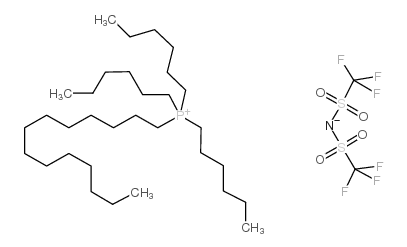460092-03-9
| Name | bis(trifluoromethylsulfonyl)azanide,trihexyl(tetradecyl)phosphanium |
|---|---|
| Synonyms |
tetradecyltrihexylphosphonium NTf2
Tetradecyltrihexylphosphonium bis(trifluoromethylsulfonyl)amide [PR4][Tf2N] MFCD04117695 Trihexyltetradecylphosphonium bis(trifluoromethylsulfonyl)amide [P6,6,6,14][NTf2] [TDTHP][NTf2] [THTDP][NTf2] |
| Density | 1.07 g/mL at 20ºC(lit.) |
|---|---|
| Molecular Formula | C34H68F6NO4PS2 |
| Molecular Weight | 764.00200 |
| Flash Point | 52ºC |
| Exact Mass | 763.42300 |
| PSA | 98.63000 |
| LogP | 15.66690 |
| Appearance | liquid | colorless |
|
Section 1: Product Identification Chemical Name:Trihexyl(tetradecyl)phosphonium bis(trifluoromethanesulfonyl)amide, min. 97% CYPHOS IL 109 CAS Registry Number:460092-03-9 Formula:[(C6H13)3(C14H29)P]+[(CF3SO2)N]- EINECS Number:none Chemical Family:organophosphine compound Synonym:CYPHOSIL 109
Section 2: Composition and Information on Ingredients IngredientCAS NumberPercentACGIH (TWA)OSHA (PEL) Title compound460092-03-9100%2.5mg(F)/m32.5mg(F)/m3 Section 3: Hazards Identification Emergency Overview:Irritating to skin, eyes and respiratory tract. May be harmful if swallowed. Primary Routes of Exposure:Ingestion, skin Eye Contact:Causes mild to moderate irritation to the eyes. Skin Contact:Causes mild to moderate irritation of the skin. Inhalation:As a liquid aerosol, irritating to the nose, mucous membranes and respiratory tract. Ingestion:No specific information is available on the physiological effects of ingestion. May be harmful if swallowed. Acute Health Affects:Irritating to skin, eyes and respiratory tract. May be harmful if swallowed. Product contains fluorine which, under certain conditions of use, decomposition or metabolism, may generate Chronic Health Affects:fluoride ion causing nausea, vomiting, labored breathing, hypocalcaemia, deterioration of bone and tooth structure and kidney and liver damage. NTP:No IARC:No OSHA:No SECTION 4: First Aid Measures Immediately flush the eyes with copious amounts of water for at least 10-15 minutes. A victim may need Eye Exposure: assistance in keeping their eye lids open. Get immediate medical attention. Wash the affected area with water. Remove contaminated clothes if necessary. Seek medical assistance if Skin Exposure: irritation persists. Remove the victim to fresh air. Closely monitor the victim for signs of respiratory problems, such as difficulty Inhalation: in breathing, coughing, wheezing, or pain. In such cases seek immediate medical assistance. Seek medical attention immediately. Keep the victim calm. Give the victim water (only if conscious). Induce Ingestion: vomiting only if directed by medical personnel. SECTION 5: Fire Fighting Measures Flash Point:no data Autoignition Temperature:none Explosion Limits:none Extinguishing Medium:carbon dioxide, dry powder or foam. Fire fighters should be equipped with a NIOSH approved positive pressure self-contained breathing apparatus Special Fire Fighting Procedures: and full protective clothing. Hazardous Combustion andIf involved in a fire this material may emit toxic organic fumes and vapors of phosphorus pentoxide. Decomposion Products: Unusual Fire or Explosion Hazards: No unusual fire or explosion hazard. SECTION 6: Accidental Release Measures Small spills can be mixed with vermiculite, sodium carbonate or other suitable non combustible adsorbent and Spill and Leak Procedures: swept up. SECTION 7: Handling and Storage Handling and Storage:Keep container tightly closed. Store in a cool, dry place. SECTION 8: Exposure Controls and Personal Protection Eye Protection:Always wear approved safety glasses when handling a chemical substance in the laboratory. Skin Protection:Wear protective clothing and gloves. Ventilation:Handle the material in an efficient fume hood. If ventilation is not available a respirator should be worn. The use of respirators requires a Respirator Respirator: Protection Program to be in compliance with 29 CFR 1910.134. Ventilation:Handle the material in an efficient fume hood. Additional Protection:No additional protection required. SECTION 9: Physical and Chemical Properties Color and Form:colorless liq. Molecular Weight:764 Melting Point:no data Boiling Point:no data Vapor Pressure:no data Specific Gravity:no data Odor:none Solubility in Water:insoluble SECTION 10: Stability and Reactivity Stability:air and moisture stable Hazardous Polymerization:no hazardous polymerization Conditions to Avoid:none Incompatibility:strong oxidizing agents Decomposition Products:carbon monoxide, phosphorous pentoxide, sulfur and nitrogen oxides, hydrofluoric acid and organic fumes. SECTION 11: Toxicological Information RTECS Data:No information available in the RTECS files. Carcinogenic Effects:no data Mutagenic Effects:no data Tetratogenic Effects:no data SECTION 12: Ecological Information Ecological Information:No information available SECTION 13: Disposal Considerations Disposal:Dispose of according to federal, state, and local regulations. SECTION 14: Transportation Shipping Name (CFR):Non-hazardous Hazard Class (CFR):NA Additional Hazard Class (CFR):NA Packaging Group (CFR):NA UN ID Number (CFR):NA Shipping Name (IATA):Non-hazardous Hazard Class (IATA):NA Additional Hazard Class (IATA):NA Packaging Group (IATA):NA UN ID Number (IATA):NA SECTION 15: Regulatory Information TSCA:Not listed in the TSCA inventory. SARA (Title 313):Title compound not listed. Second Ingredient:none SECTION 16 - ADDITIONAL INFORMATION N/A |
| Hazard Codes | C |
|---|---|
| Risk Phrases | R10;R22;R34 |
| Safety Phrases | S26;S45;S36/S37/S39 |
| RIDADR | UN 2920 8/PG 2 |
| WGK Germany | 3 |
